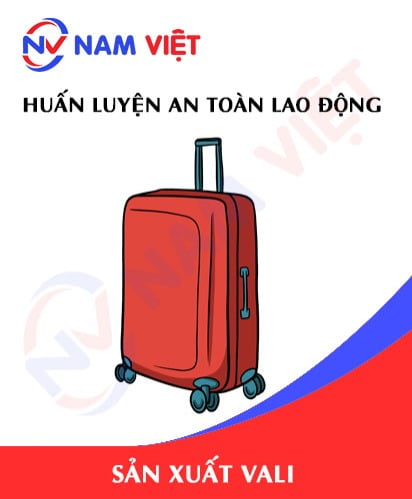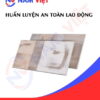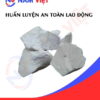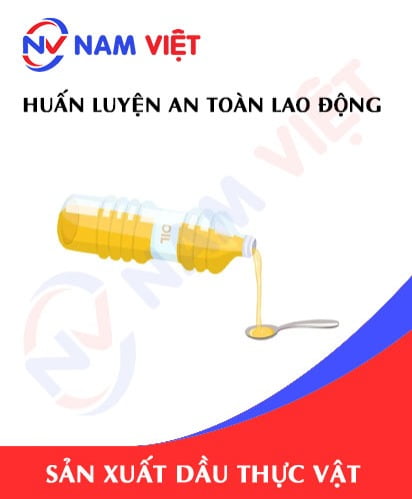Occupational safety training for suitcase manufacturing
99,000 ₫
Note: The above price is calculated per person, the price may fluctuate depending on the number of learners participating in the course and the market movement, for more accurate price support please refer to the pricing table or contact our consultants directly.
Occupational safety is an important issue in factories manufacturing suitcases and needs to be addressed promptly to ensure the health and safety of workers, enhancing the reputation of businesses. The Safety training course is one of the effective solutions to raise awareness about how to prevent occupational accidents for workers involved in manufacturing suitcases.
Table of Contents
Toggle1. Overview of the Suitcase
a. What is a suitcase?
- A suitcase is a type of luggage designed to hold belongings when traveling or moving. Suitcases are often made from materials like leather, plastic, fabric, and metal, and come in various sizes and styles to suit users’ needs. A suitcase typically has a handle and wheels for easy mobility, and it may also have a lock or security code to ensure the safety of the belongings inside. The suitcase is a popular product used widely around the world, especially for longer trips or flights.
- The suitcase manufacturing industry in Vietnam is currently developing and contributes significantly to the global tourism and luggage industry. Vietnam has a developed textile and garment industry, so the suitcase manufacturing industry also benefits from this.
- According to statistics from the General Statistics Office of Vietnam, in recent years, Vietnam’s suitcase export output has seen significant growth. In 2020, the total value of suitcase exports reached over 1.6 billion USD, a 10.6% increase compared to the previous year. The major markets for Vietnam in the suitcase manufacturing industry are the United States, Europe, and Japan.
- Vietnamese businesses in the suitcase manufacturing industry have invested heavily in researching and developing new products, improving product quality and design to compete with other countries in the international market. Many Vietnamese suitcase businesses have achieved international quality certifications such as ISO 9001 and ISO 14001.

b. Types of machinery for suitcase manufacturing
There are many types of machinery used in suitcase manufacturing, including:
- Cutting machine: used to cut suitcase parts from fabric or leather sheets.
- Sewing machine: used to sew the parts together to form a complete suitcase.
- Welding machine: used to heat-weld suitcase parts to create strong and waterproof joints.
- Pressing machine: used to press suitcase parts to increase product durability.
- Printing machine: used to print images, logos, or designs on the surface of the suitcase.
- Wheel testing machine: used to test the quality and durability of the suitcase by running it on its wheels on various surfaces.
- Cutting and gluing machine: used to cut and glue leather or fabric pieces onto the suitcase.
In addition, modern suitcase manufacturing machines are also integrated with automation and computer control technology, which helps increase productivity, reduce costs, and improve product quality.
c. Representative suitcase manufacturing companies
There are many suitcase manufacturing businesses in Vietnam; here are some representative ones:
- Saigon First Group (First Vietnam Co., Ltd.): is one of the leading companies in Vietnam in the field of manufacturing suitcases, handbags, leather wallets, and related products. The company has many years of experience and is trusted by customers for its high product quality and good service.
- Tan Phuc Hung One Member Co., Ltd.: is a company specializing in the production of various types of suitcases, handbags, backpacks, and other leather products. The company was established in 2003 and has over 15 years of experience in the manufacturing industry.
- Thanh Long One Member Co., Ltd.: is one of the large-scale manufacturers of suitcases, handbags, and leather products in Vietnam. The company was established in 2000 and has many years of experience in the industry.
- Minh Long One Member Co., Ltd.: is a company specializing in the production of various types of suitcases, handbags, backpacks, and other leather products. The company was established in 1996 and has over 25 years of experience in the manufacturing industry.
- Tuan Hung One Member Co., Ltd.: is one of the companies specializing in the production of high-end leather products, including suitcases, handbags, backpacks, and other products. The company was established in 2000 and has over 20 years of experience in the manufacturing industry.

d. Specific jobs in a suitcase manufacturing factory
Group 1
- Executive Director, Deputy Executive Director, department heads in a suitcase manufacturing factory.
Group 2
- Safety officer: manages safety in the factory, designs safety procedures, supervises and urges employees to comply with safe working procedures.
Group 3
- Material preparation: necessary materials for suitcase manufacturing such as fabric, leather, zippers, locks, hooks, lining, foam, etc., will be prepared and checked for quality before use.
- Fabric cutting: suitcase patterns will be cut from fabric sheets according to the design drawings.
- Sewing: after the fabric is cut, the suitcase parts will be sewn together to create a finished product.
- Assembly: the suitcase parts will be assembled, and accessories such as zippers, locks, hooks, etc., will be attached to the product.
- Quality control: after the product is completed, quality control staff will check every detail to ensure that the product meets quality standards.
- Packaging and shipping: the suitcase products will be packaged and shipped to stores or end customers.
Group 4
- Office work, serving, sales, marketing.
- Production management, quality management, human resource management, material management, financial and accounting management.
- Research and development of new products.
- Product design: the design team will create new suitcase models or improve existing ones to meet customer needs.
e. Common types of suitcases on the market
On the market today, there are many types of suitcases with different sizes, styles, and functions. Below are some common types of suitcases on the market:
- Travel suitcase: This type of suitcase is usually large to hold belongings for a trip. It can be a rolling suitcase or a duffel bag, often made of fabric, leather, or hard plastic. Travel suitcases are often designed with multiple compartments and convenient pockets for users to easily organize their belongings.
- Carry-on luggage: This type of suitcase is usually smaller than a travel suitcase and is designed to hold personal belongings for a short trip or a business trip. Carry-on luggage can be a rolling suitcase or a duffel bag, made of fabric, leather, or hard plastic.
- Handheld suitcase: This compact type of suitcase is often used to hold personal items such as a phone, wallet, passport, tablet, etc., when traveling or moving. A handheld suitcase can be carried crossbody or by hand, and is made of fabric, leather, or hard plastic.
- Laptop suitcase: This type of suitcase is specially designed to hold and protect a laptop when traveling. A laptop suitcase is often made of durable fabric or leather, with multiple compartments to hold personal items and other electronic devices.
- Sports suitcase: This type of suitcase is designed to hold belongings for sports activities such as tennis, golf, basketball, etc. A sports suitcase is often larger than other types of suitcases and is made of waterproof or durable fabric.
Additionally, there are other types of suitcases such as watch cases, makeup cases, tool cases, camera cases, etc., depending on the user’s needs.

2. Overview of the occupational safety training course for suitcase manufacturing
In this article, we focus on the issues surrounding Group 3, because Group 3 is the group directly involved in the production process, bearing the highest risk of occupational safety. Learn more about other groups here
a. What is Group 3 occupational safety training?
- Occupational safety training for Group 3 are sessions that provide awareness on how to prevent occupational accidents for workers.
- The occupational safety training course will help workers recognize and prevent dangers, and limit the risks of occupational accidents while working.
REGISTER FOR OCCUPATIONAL SAFETY TRAINING SERVICES
b. Training time
First-time safety training time
- The total training time is at least 24 hours, including the test time.
- 8 hours of theoretical study on the system of policies and laws on occupational safety and hygiene
- 8 hours of theoretical study on basic knowledge of occupational safety and hygiene
- 4 hours of theoretical study on specialized training content
- 2 hours of practical study on specialized training content
- 2 hours of theoretical test at the end of the training course
The safety training center will divide the time into many training sessions depending on the time arrangement for employees. But usually, there will be 6 training sessions, and the course will last for 3 days, provided that the manufacturing company can arrange continuous study time.
Periodic safety training time
- Before the occupational safety card expires, if the employee wants it reissued, they must undergo a periodic occupational safety training course, with the periodic safety training time being at least 50% of the first-time safety training time.
Explanation: The total periodic occupational safety training time is at least 12 hours, including the test time. After completing the periodic training course and passing the required test, the employee will be re-issued or have their occupational safety card renewed.
c. Content of the training course
| No. | TRAINING CONTENT | TRAINING TIME (HOURS) | |||
| Total | Of which | ||||
| Theory | Practice | Test | |||
| I | System of policies and laws on occupational safety and hygiene | 8 | 8 | 0 | 0 |
| 1 | Overview of the system of legal documents on occupational safety and hygiene. | 6 | 6 | ||
| 2 | System of standards and technical regulations on occupational safety and hygiene. | 1 | 1 | ||
| 3 | Specific regulations of state management agencies on occupational safety and hygiene when newly constructing, expanding or renovating works, facilities for the manufacturing, use, storage, and inspection of machinery, equipment, materials, and substances with strict requirements on occupational safety and hygiene. | 1 | 1 | ||
| II | Basic knowledge of occupational safety and hygiene | 8 | 8 | 0 | 0 |
| 1 | Basic knowledge of dangerous and harmful factors at the workplace. | 4 | 4 | ||
| 2 | Methods for improving working conditions. | 1 | 1 | ||
| 3 | Safety culture in manufacturing and business. | 1 | 1 | ||
| 4 | Rights and obligations of employers and employees; policies and regimes on occupational safety and hygiene for employees; functions and duties of the occupational safety and hygiene network. | 1 | 1 | ||
| 5 | Occupational safety and hygiene regulations, safety signs, safety instructions and the use of safety equipment, personal protective equipment; professional skills for first aid in occupational accidents, prevention of occupational diseases. | 1 | 1 | ||
| III | Specialized training content | 6 | 4 | 2 | 0 |
| General knowledge about types of machinery, equipment, and substances that generate dangerous and harmful factors; analysis, assessment, management of occupational safety and hygiene risks, and safe working procedures with machinery, equipment, and substances with strict requirements on occupational safety and hygiene. | 6 | 4 | 2 | ||
| IV | Safety training test at the end of the training course | 2 | 2 | 0 | 0 |
| Total | 24 | 22 | 2 | ||
See more training content for 6 groups
d. Occupational safety card
After completing the occupational safety training course and passing the test, the employee will be issued an occupational safety card (commonly referred to as a group 3 occupational safety certificate).
The group 3 safety card will clearly show information such as: full name, date of birth, specific job, and working environment. It will also have the training time, a red stamp, and a signature confirming the completion of the training course.
According to the regulations on issuing safety cards clearly stated in clause 2 of Article 24 of Decree 44/2016/ND-CP, there are two cases:
- If the employer and the employee have a labor contract, the employer must sign, stamp and affix a seal on the safety card for the trained person in Group 3 after they complete the training course from the occupational safety training unit and pass the test.
- If the employee is a freelancer, seasonal worker, and does not have a labor contract, the training unit must sign, stamp and affix a seal on the safety card for the employee after they complete the training course from the occupational safety training unit and pass the test.

3. Identifying dangers in suitcase manufacturing
The dangers in suitcase manufacturing can include:
- When manufacturing suitcases, employees often have to use mechanical equipment, machinery, and sharp tools, which can easily cause occupational accidents if not used correctly. Risks include cuts, punctures, stabs, and crushing.
- During the suitcase manufacturing process, flammable or explosive chemicals may be used. If not used correctly or stored unsafely, they can cause fires and explosions.
- During the suitcase manufacturing process, polluting waste such as fabric, foam, paper, and chemicals may be generated.
- Suitcase manufacturing workers may be exposed to toxic chemicals or dust, causing health problems such as pneumonia, allergies, cancer, or headaches.
4. Common occupational accidents in suitcase manufacturing
Common occupational accidents during the suitcase manufacturing process may include:
- Cuts, punctures, stabs: Suitcase manufacturing employees often have to use tools such as scissors, knives, hammers, nails, etc. If not used correctly or properly maintained, they can cause accidents during use.
- Crushing, collisions: During transportation, machine parts or suitcase shells may collide, causing damage and accidents to the transport personnel.
- Fire and explosion: During the suitcase manufacturing process, flammable or explosive chemicals may be used. If not used correctly or stored unsafely, they can cause fires and explosions.
- Worker health: Suitcase manufacturing employees are often exposed to toxic chemicals or dust, causing health problems such as pneumonia, allergies, cancer, or headaches.
5. Safety measures for suitcase manufacturing
To ensure the safety of workers during the suitcase manufacturing process, the following safety measures should be applied:
- Workers need to be fully equipped with PPE, including helmets, protective glasses, masks, gloves, safety shoes, etc., to ensure safety while working.
- Ensure a clean, airy, and well-lit environment and prevent workers from being exposed to toxic substances, dust, bacteria, etc.
- Ensure that the suitcase manufacturing equipment is working properly and is regularly maintained to minimize malfunctions and the risk of occupational accidents.
- Suitcase shells need to be tightly packed and clearly marked to avoid collisions or damage during transportation.
- Occupational safety training for employees on occupational safety and production procedures to minimize risks during work.
- Proper waste disposal: Waste from the suitcase manufacturing process needs to be handled properly and separated from other waste to ensure a healthy environment.
- Regular inspection and supervision: Regularly inspect and supervise production activities to detect and fix problems early, ensuring the safety of employees and consumers.
- Periodically organize work environment monitoring in factories and enterprises, collect and analyze harmful factors to workers, thereby adjusting to reduce the level of danger to prevent occupational diseases for them.

6. Benefits of occupational safety training for suitcase manufacturing
An Toan Nam Viet provides businesses with great benefits after completing occupational safety training courses according to the regulations in Decree 44/2016/ND – CP on occupational safety and hygiene, for companies, factories, and enterprises.
- Workers can recognize the potential risks of occupational accidents and take preventive measures to avoid accidents.
- Businesses can establish risk prevention measures in production, operation, and maintenance procedures.
- Reduce costs when occupational safety risks occur.
- An uninterrupted production process will help increase labor productivity and product quality.
- Comply with occupational safety laws, avoiding legal risks.
- Create prestige and professionalism in all aspects, thereby enhancing the brand for your business.
An Toan Nam Viet’s training courses are the solution to prevent and combat external factors affecting each individual so that they can avoid dangers that can lead to injury or, more seriously, death.
REGISTER FOR OCCUPATIONAL SAFETY TRAINING SERVICES
7. Customer feedback after completing the occupational safety training course for suitcase manufacturing
An Toan Nam Viet has many years of experience in the mission of accompanying many businesses in Vietnam in general and in the southern provinces in particular. And that responsibility is something very precious to An Toan Nam Viet, which is why An Toan Nam Viet’s Occupational Safety Training has always been focused on becoming more and more professional. The motivation for An Toan Nam Viet to grow strongly to this day comes from the positive and constructive feedback from businesses. Below is the feedback from our partners that we have served.
Bac Nam E&C Investment and Construction Joint Stock Company
“The first time I used the service at An Toan Nam Viet, I was very surprised by the enthusiastic 24/7 support of the team of consultants. The class organization was very quick and convenient for our company, thank you very much for An Toan Nam Viet’s service!”
Hoa Dat Construction and Trading Joint Stock Company
“An Toan Nam Viet’s service has helped us a lot in simplifying occupational safety and completing safety records for our work process. The team of consultants is enthusiastic and timely in answering our questions. 5 stars for An Toan Nam Viet”
See more customer interviews after using the service from An Toan Nam Viet
8. An Toan Nam Viet’s occupational safety training capacity
An Toan Nam Viet is a reputable and high-quality occupational safety training center in Vietnam today. With occupational safety training sessions continuously taking place at production workshops, factories, or construction sites across the country (all 63 provinces and cities in Vietnam).
REGISTER FOR OCCUPATIONAL SAFETY TRAINING SERVICES
Occupational safety training license
- An Toan Nam Viet has been inspected by the Safety Department of the Ministry of Labor – Invalids and Social Affairs and granted a certificate of eligibility to operate occupational safety and hygiene training. This further strengthens our capacity for occupational safety training.

Materials and lectures
- Before the occupational safety training materials are put into the occupational safety training courses, they are reviewed and censored to ensure that the lectures are accurate in terms of knowledge and effective when applied.
- The teaching method of the lecturers is synchronized according to the teaching standards of An Toan Nam Viet, which is a method that experts in occupational safety and hygiene training have researched and drawn from the teaching process to bring the highest knowledge acquisition efficiency to students.
Facilities
- Controlling the factors in the classroom that affect the training process will increase the teaching performance and the knowledge acquisition efficiency of students.
- Our training course support facilities always arrange spacious classrooms that meet standards for area, lighting, training equipment, etc.
9. Reputable and high-quality national safety training center
At An Toan Nam Viet, we always put our professional dedication to occupational safety training as a top priority. For us, imparting knowledge to workers on how to protect themselves so that they have a safe journey on their path to making a living is a contribution to nation-building.
To ensure the effectiveness of the training, we prepare carefully and meticulously every little detail. From preparing tools, equipment, and teaching devices to textbooks, documents, sound, and lighting.
Our occupational safety training lecturers are experts with many years of experience in the field. They even have research projects to identify dangers in all occupations and how to prevent them.
The lecturers’ lectures are drawn from reality and delivered in a vivid and easy-to-imagine way for workers. These factors help workers feel comfortable during their study time and acquire the knowledge we teach well. Of course, the knowledge imparted is always closely aligned with Decree 44/2016/ND-CP.
From there, they can grasp many measures to prevent dangers and how to protect themselves. At the same time, they can apply it in the most suitable way in their actual work.
Our safety training center is proud to be a reputable and professional provider of occupational safety training services with the following advantages:
- Competitive training costs but guaranteed training quality.
- Flexible training schedule based on the production situation of the company.
- Fast and legally compliant procedures for issuing occupational safety training certificates.
- Lecturers are people with many years of experience in the profession.
- The classroom environment is controlled for factors that affect the training process, increasing teaching performance and knowledge acquisition efficiency for students.
- The lectures are compiled to be suitable for occupational safety work at businesses.
- An Toan Nam Viet works with dedication and professionalism to support customers accurately and quickly.

10. Additional reference materials for occupational safety training in suitcase manufacturing
- Occupational safety documents for suitcase manufacturing
- Set of occupational safety training materials
- Set of occupational safety training test questions
- Multiple-choice test for occupational safety in suitcase manufacturing
- Slides for the occupational safety training lecture in suitcase manufacturing
1 review for Occupational safety training for suitcase manufacturing
No comments yet















namchinh.haiphong341
Dịch vụ huấn luyện an toàn lao động rất tốt nhé, giảng viên dạy rất sinh động dễ hiểu!